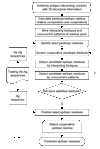Mining for the antibody-antigen interacting associations that predict the B cell epitopes
- PMID: 20487513
- PMCID: PMC2873829
- DOI: 10.1186/1472-6807-10-S1-S6
Mining for the antibody-antigen interacting associations that predict the B cell epitopes
Abstract
Background: Predicting B-cell epitopes is very important for designing vaccines and drugs to fight against the infectious agents. However, due to the high complexity of this problem, previous prediction methods that focus on linear and conformational epitope prediction are both unsatisfactory. In addition, antigen interacting with antibody is context dependent and the coarse binary classification of antigen residues into epitope and non-epitope without the corresponding antibody may not reveal the biological reality. Therefore, we take a novel way to identify epitopes by using associations between antibodies and antigens.
Results: Given a pair of antibody-antigen sequences, the epitope residues can be identified by two types of associations: paratope-epitope interacting biclique and cooccurrent pattern of interacting residue pairs. As the association itself does not include the neighborhood information on the primary sequence, residues' cooperativity and relative composition are then used to enhance our method. Evaluation carried out on a benchmark data set shows that the proposed method produces very good performance in terms of accuracy. After compared with other two structure-based B-cell epitope prediction methods, results show that the proposed method is competitive to, sometimes even better than, the structure-based methods which have much smaller applicability scope.
Conclusions: The proposed method leads to a new way of identifying B-cell epitopes. Besides, this antibody-specified epitope prediction can provide more precise and helpful information for wet-lab experiments.
Figures








References
-
- Jerne NK. Immunological speculations. Annu. 1960;14:341–358. - PubMed
-
- Van Regenmortel MHV. Mapping Epitope Structure and Activity: From One-Dimensional Prediction to Four-Dimensional Description of Antigenic Specificity. Methods. 1996;9(3):465–472. - PubMed
-
- Levitt M. A simplified representation of protein conformations for rapid simulation of protein folding. J. 1976;104:59–107. - PubMed
-
- Karplus P, Schulz G. Prediction of chain flexibility in proteins: a tool for the selection of peptide antigen. Naturwissenschaften. 1985;72(4):212–213.
Publication types
MeSH terms
Substances
LinkOut - more resources
Full Text Sources
Other Literature Sources
Research Materials
Miscellaneous

